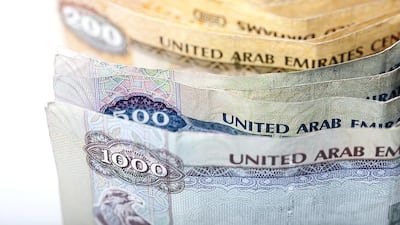The UAE Central Bank reduced banking sector liquidity for a second consecutive month in August, a move analysts believe signifies an easing of pressure on lenders.
The central bank removed Dh3.1 billion of excess liquidity from the banking system in August, taking the total withdrawals to Dh11.3bn in two months, WAM, the UAE's official news agency reported on Sunday. The bank has pumped Dh31.6bn into the banking system since the beginning of the year.
"Liquidity support from the UAE central banks is no longer required, in our view, because [the] Eibor-Libor spread has tightened," said Jaap Meijer, head of research at Arqaam Capital, the Dubai-based investment bank, referring to the premium that borrowers pay for the Emirates Inter Bank Offered Rate over the benchmark US dollar London Interbank Offered Rate that global banks use to lend dollars to each other.
"Last year, the GCC banking market suffered from liquidity drainage as governments withdrew deposits from the system as oil revenues dropped sharply. That caused spreads versus Libor to rise sharply, especially in Saudi. Liquidity conditions have since improved, as oil price has rebounded and government have diversified their funding requirements."
The bank's removal of the excess liquidity was accompanied by a rise in the sale of certificates of deposits (CDs), which in August rose to Dh114.4bn from Dh111.1bn in July and Dh102.8bn in June, according to WAM.
"CDs are a liquidity management tool of the UAE central bank," said Shabbir Malik, a Dubai-based banking analyst at EFG-Hermes.
"When there is excess liquidity in the system, the central bank sells CDs to the banks to manage liquidity and domestic interest rates. The amount of money withdrawn by the central banks is not significant in context of the banking system. Loan growth is very weak this year for UAE, so the surplus liquidity would typically end up in central bank CDs."
CDs are a key monetary policy tool for the UAE Central bank. The UAE dirham's peg to the US dollar acts as constraint on the bank's ability to control monetary supply via interest rates, in common with central banks in other Arabian Gulf countries, with interest rate moves taking their lead from the US Federal Reserve.
No one at the central bank was immediately available to comment.
_______________
Read more:
Low liquidity leads to rise in syndicated loans
Business lending recovery to strengthen UAE banks
________________
UAE banks, like their regional peers, have been hit hard since the crash in oil prices in 2014, after which government deposits declined, pushing up interbank lending rates. Alex Thursby, the former chief executive of National Bank of Abu Dhabi, said in October 2015 that UAE banks had lost more than U$15bn in government deposits from September 2014, when the drop in oil price began to accelerate.
Money has begun to flow back into UAE bank coffers this year with the partial recovery of oil prices and the prospect of an uptick in economic activity in 2018 and beyond. Government spending on infrastructure projects ahead of Dubai's hosting of Expo2020 has given a boost to both the economy and banks, despite expectations of loan growth this year.
Abdulaziz AlGhurair, the chief executive of Mashreq Bank, told the National this month that he expected loan growth to be flat this year as many businesses and individuals take a wait and see approach.
The reduction of liquidity in the banking system suggests the central bank is also concerned about an excessive rise in consumer prices.
"This [move] suggests the Central Bank of the UAE sees too much liquidity in the banking system and is mopping it up," said Sanyalaksna Manibhandu, head of research at NBAD Securities. "Too much liquidity could be inflationary."

